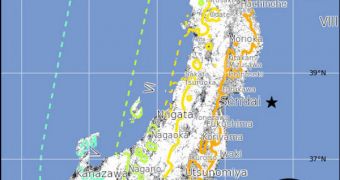Japanese authorities have been expecting an earthquake similar to the one that struck the country for nearly three decades now, but they were surely not expecting it to strike in the region it did.
Geologists say that the fault line that ruptured to produce the magnitude 9.0 tremor that struck 80 miles east of the city of Senday, and 155 miles northeast of Tokyo, was not believed to be capable of producing such devastation.
In other words, the event was expected to originate elsewhere, in fault lines that have a “reputation” for producing massive earthquakes. However, obviously did not happen, and the tremor originated at a depth of only 32 kilometers (19.9 miles), in a relatively unknown portion of oceanic crust.
On March 11, the area experienced a rupture that triggered an event about 1,000 times more intense than the magnitude 7.0 tremor that struck Haiti in January 2010, killing over 230,000 people.
“This area has a long history of earthquakes, but [the Sendai earthquake] doesn’t fit the pattern. The expectation was high for a 7.5, but that’s a hundred times smaller than a 9.0,” says Harold Tobin.
The expert, who holds an appointment as a marine geophysicist at the University of Wisconsin–Madison (UWM), explains that determining how and why earthquakes are produced around Japan is a very complex task.
The country sits on the Pacific Ring of Fire, an area circling the ocean where tectonic plates slam into each other, and compete for supremacy. The nation is located at the boundary of the Asian plate with the Pacific plate, and the two collide rather often.
Though the Japan Trench – the area where the epicenter was located – produced several large tremors over the past century, none of these events was more intense than magnitude 8.0, Science News reports.
As such, experts and authorities were convinced that the “next big one” will strike from the south, where the Japanese plate is colliding with the Philippine plate. The latter is moving north.
Experts at the Harvard University already carried out a computer simulation of the March 11 event and determined that more than 390 kilometers of the Japan Trench ruptured during the earthquake.
“It looks like three of the segments [int the Trench] all slipped together. There is some evidence that a fourth may have been involved as well,” explains Harvard seismologist Miaki Ishii.
“We’re learning that we can’t discount any of these big subduction zones. They’re all capable of producing large earthquakes,” Tobin concludes.

 14 DAY TRIAL //
14 DAY TRIAL //